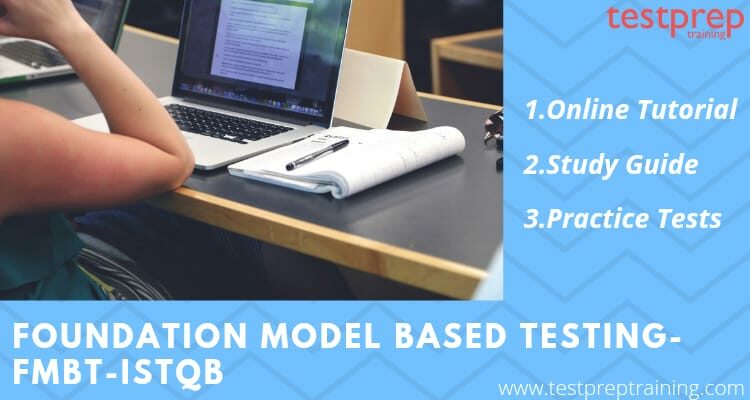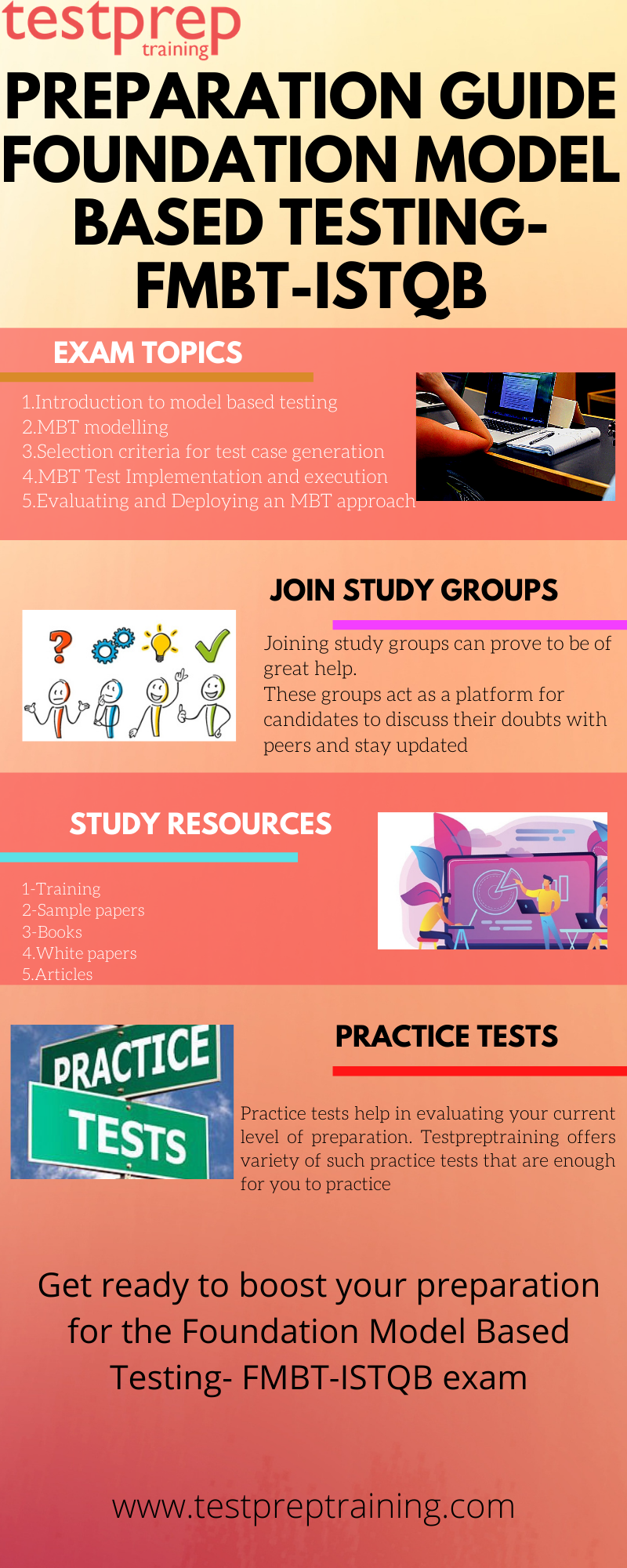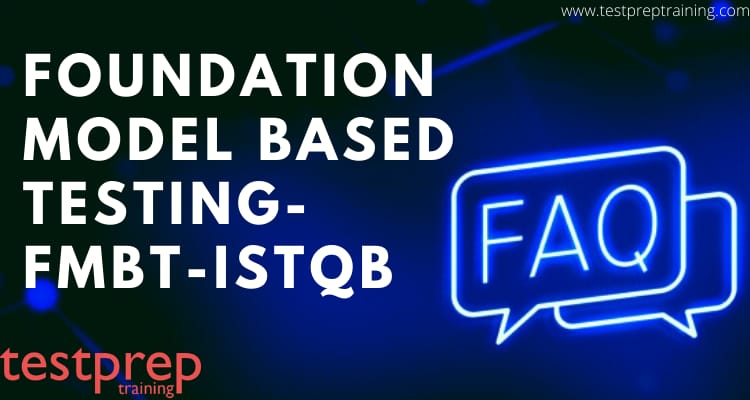Foundation Model-Based Testing-FMBT-ISTQB

The Foundation Model-Based Testing-FMBT-ISTQB exam is a specialist module at the foundation level. The content of the Model-Based Tester syllabus provides
additional skills for professional testers. This certification exam validates and broadens the understanding of testing acquired at the foundation level to enable capabilities required for the Model-Based Testing (MBT) process, methodology, and techniques.
Eligibility Criteria
Well, to be eligible to take the Foundation Model-Based Testing-FMBT-ISTQB certification exam, one must first pass the ISTQB Foundation Certification exam. After that in order to take the exam, one can find the local exam provider here.
Target Audience
Moreover, this exam is intended for the following groups of people:
- Testers
- Test Analysts
- Technical Test Analysts
- Test Managers
- Product Managers
- Business Analysts
- Business Process Experts
- System and Software Developers and Architects
- Project Managers
- Quality Managers
Benefits
Consequently, passing the Foundation Model-Based Testing-FMBT-ISTQB exam enables the candidate in-
- Collaborating in model-based testing teams using the standard terminologies and established MBT concepts, processes, and techniques.
- Applying and integrating model-based testing in test processes.
- Effectively creating and maintaining MBT models with the use of established techniques and best practices of model-based testing.
- Selecting, creating, and maintaining test artifacts from MBT models considering the risk and value of the features tested.
- Supporting the organization in improving its quality assurance process to be more efficient.
Learning Outcomes
Additionally, the Foundation Model-Based Testing-FMBT-ISTQB exam has the following learning objectives-
- Objectives and motivations for model-based testing
- MBT modeling
- Test selection criteria that are used in model-based testing
- Activities specific to MBT and essential MBT artifacts
- Integrating MBT into the software development lifecycle
- MBT test implementation and its execution
- Evaluating and deploying an MBT Approach
Exam Details
| Module | Foundation Model-Based Testing-FMBT-ISTQB |
| Exam Duration | 60 minutes/ 75 minutes(for those who are not taking exam in their spoken language) |
| Passing Score | 65% |
| Number of Questions | 40 |
| Type of Questions | Multiple-choice type |
For more details and any other queries, visit the Foundation Model-Based Testing-FMBT-ISTQB exam FAQs
Foundation Model-Based Testing-FMBT-ISTQB exam Course Outline
The syllabus for the Foundation Model-Based Testing-FMBT-ISTQB exam has been divided into sections and subsections, given as follows-
1. Introduction to Model-Based Testing
1.1 Objectives and Motivations for MBT
1.1.1 Main Motivations for MBT
1.1.2 Misleading Expectations and Pitfalls of MBT
1.2 MBT Activities and Artifacts in the Fundamental Test Process
1.2.1 MBT Specific Activities
1.2.2 Essential MBT Artifacts (Inputs and Outputs)
1.3 Integrating MBT into the Software Development Lifecycles
1.3.1 MBT in Sequential and Iterative Software Development Lifecycles
1.3.2 Supporting Requirements Engineering
2. MBT Modeling
2.1 MBT Modeling
2.1.1 MBT Modeling Activities
2.1.2 Subject and Focus of MBT Models
2.1.3 MBT Models Depend on Test Objectives
2.2 Languages for MBT Models
2.2.1 Main Categories of Modeling Languages for MBT
2.2.2 Language Categories Relevant for Different Systems and Project Objectives
2.3 Good Practices for MBT Modeling Activities
2.3.1 Quality Characteristics for MBT Models
2.3.2 Typical Mistakes and Pitfalls in MBT Model Design
2.3.3 Linking Requirements and Process Related Information to the MBT Model
2.3.4 Modeling Guidelines for MBT
2.3.5 Reuse of Existing System Design or Requirements Models
2.3.6 Tool Support for Modeling Activities
2.3.7 Iterative Model Development, Review and Validation
3. Selection Criteria for Test Case Generation
3.1 Classification of MBT Test Selection Criteria
3.1.1 Test Selection Criteria
3.1.2 Test Case Selection in Practice
3.1.3 Examples of Test Selection Criteria
3.1.4 Relation to Foundation Level Test Design Techniques
3.2 Applying Test Selection Criteria
3.2.1 Degree of Automation in Test Generation
3.2.2 Pros and Cons of Specific Test Selection Criteria
3.2.3 Good Practices of MBT Test Selection
4. MBT Test Implementation and Execution
4.1 Specifics of MBT Test Implementation and Execution
4.1.1 Abstract and Concrete Test Cases in the MBT Context
4.1.2 Different Kinds of Test Execution
4.1.3 The Impact of Changes on the MBT Artifacts
4.2 Activities of Test Adaptation in MBT
5. Evaluating and Deploying an MBT Approach
5.1 Evaluate an MBT Deployment
5.1.1 ROI Factors for MBT Introduction
5.1.2 Organizational Objectives and their Relationship to the Characteristics of the MBT Approach
5.1.3 Metrics and Key Performance Indicators
5.2 Manage and Monitor the Deployment of an MBT Approach
5.2.1 Good Practices when Deploying MBT
5.2.2 Cost Factors of MBT
5.2.3 Integration of the MBT Tool
Foundation Model-Based Testing-FMBT-ISTQB Exam Study Guide
First of all, you should familiarize yourself with all the topics and subtopics that are there in the exam syllabus. So, this will help you gather a fair idea about required learning and will help you distribute your learning preparation. Also, the practical application of what you learn is really important so keep that in mind while studying. So, start your preparation by going through the syllabus well.

Go through the details of exam
Consequently, the next step towards preparing for the exam is to thoroughly go through the details of the exam including details about the type and number of questions and also the time allotted. Accordingly, this helps you give a direction to your learning and also analyze the time allotted so as to manage time well, during the exam. So, check the model papers and analyze them well and thus, make sure that you are aware of the pattern of the exam.
Study Resources
Consequently, for your convenience, we have compiled the best study resources for your preparation
- If you wish to study from books then this reading is highly recommended: Kramer, A., Legeard, B. (2016), Model-Based Testing Essentials: Guide to the ISTQB Certified Model-Based Tester: Foundation Level, Wiley
- ISTQB provides the following study material in their downloads section-
- White papers(to access Click here)
- Syllabus related articles(to access Click here)
- Glossary
- You can also check out these model papers for a better understanding of the pattern of the exam and the type of questions asked.
- One can also look for training in the ISTQB accredited training providers in one’s local area. You can check the list of training providers from the website of ISTQB.
Join study groups
Moreover, joining study groups and communities can also prove to be of great help. Thus, this acts as a platform that connects professionals and beginners which in a way helps you get your queries solved and alongside, gives you the opportunity to have healthy discussions with peers from the same background. Therefore, joining these groups helps to keep you updated.
Practice tests
However, the most crucial step of preparation is practicing questions. This helps in refining the knowledge that you have gathered from different study resources. Therefore, this helps in evaluating your current preparation and helps boost your confidence and hence the actual exam feels like just another practice test. There are various practice tests available online, but the reliability of the practice tests we offer is really high. Here, we provide-
- unique sets of professionally designed questions that make it easier for the candidate to give the actual exam
- mock tests
- allows you to create your own practice tests
- has a pool of experts to address your queries


